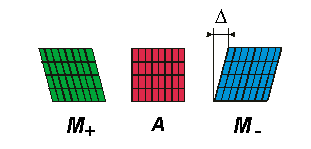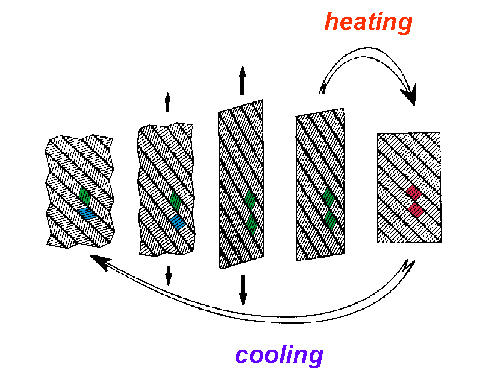Introduction
Background
User manual
Interaction
Contact
Guestbook
This page provides some background information about
The SMA model. The following section gives a short overview of the SMA model used for the simulation page. It has originally been developed by Achenbach and Müller (1982, 1985) and Achenbach (1989) and has recently been modified by Seelecke (1999) in order to make quantitative predictions, see Seelecke (2000) and Seelecke and Kastner (2000) for details. It uses ideas from statistical thermodynamics and describes the evolution of two martensite fractions based on the theory of thermally activated processes.
Under uniaxial loading conditions, three different phases can be observed in a shape memory alloy, viz. the austenite phase A and two martensitic twin variants M± , see Fig. 1 below:
 .
.
Figure 1: Lattice particle in different phases.
From crystallographic observations it is known that a macroscopic body under uniaxial loading forms a layered structure, each layer being in one of the three above phases. Motivated by this observation, we construct the model body according to Fig. 2.

Figure 2: SMA body under tensile loading/unloading at low temperature, exhibiting the shape memory effect upon heating.
The sequence in Fig. 2 shows the unloaded body at a low temperature on the left, at which the layers are in the martensitic state with an equal amount of each twin variant (green and blue). Under a tensile load, the M+-layers become flatter, while the M--layers become steeper (second from left), until the M--layers flip over to the M+-phase at a critical load (center). When the body is unloaded, the layers remain in the M+-phase, and a residual deformation results (second from right). Upon the supply of heat, the layers transform into austenite (red), and the body seems to remember its former shape, which gives the name to the effect (right). Subsequent cooling causes the austenitic layers to retransform into martensite with an equal probability for both twins to occur, and the original zig-zag shape of the surface is restored as well.
Shape memory alloys (SMAs) exhibit a very complex material behavior. Depending on load and temperature a number of unusual effects like shape memory or superelasticity may be observed in these metals. These phenomena are due to a martensite-austenite phase transition in the crystal lattice and to martensitic twinning. The interested reader is refered to the textbooks of Funakubo (1984) and Otsuka and Wayman (1999) for an introduction to the subject. A short overview can also be found here at this web site.
The material behavior of SMAs has inspired a quickly increasing number of technical applications in a diversity of fields, among them biomedicine, energy conversion, structural damping and actuation of smart structures. An overview can be found in the recent review article by Seelecke and Müller (2000) and the numerous references therein.